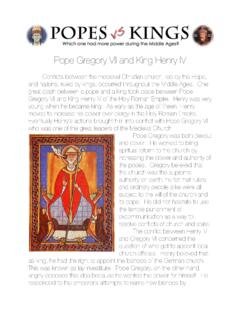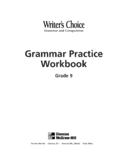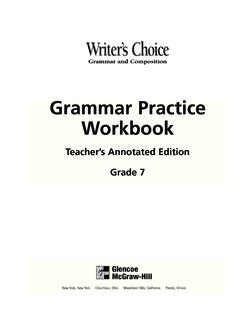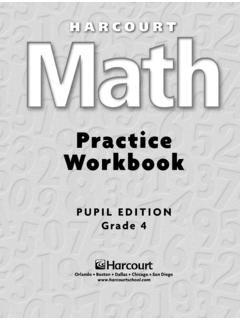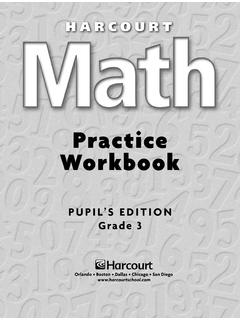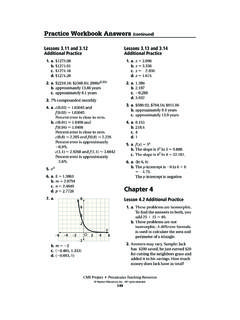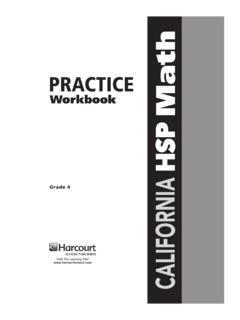Transcription of AP Physics B – Practice Workbook – Book 1
1 AP Physics B Practice Workbook Book 1 Mechanics, Fluid Mechanics and Thermodynamics .. The following( is applicable to this entire document copies for student distribution for exam preparation explicitly allowed. 1) Copyright 1973-2009 College Entrance Examination Board. All rights reserved. College Board, Advanced Placement Program, AP, AP Central, AP Vertical Teams, APCD, Pacesetter, Pre-AP, SAT, Student Search Service, and the acorn logo are registered trademarks of the College Entrance Examination Board. PSAT/NMSQT is a registered trademark of the College Entrance Examination Board and National Merit Scholarship Corporation.
2 Educational Testing Service and ETS are registered trademarks of Educational Testing Service. Other products and services may be trademarks of their respective owners. 2) 1994-2009 AAPT Has a copyright or other licensing restriction. Table of Contents Chapter 1 Kinematics Kinematics Multiple Choice ..5 Kinematics Free Response ..29 Answers to Kinematics Questions ..37 Chapter 2 Dynamics Dynamics Multiple Choice Section A Linear Dynamics ..53 Section B Circular Motion ..73 Dynamics Free Response Section A Linear Dynamics ..79 Section B Circular Motion.
3 96 Answers to Dynamics Questions ..103 Chapter 3 Torque Torque Multiple Choice ..125 Torque Free Answers to Torque Questions ..135 Chapter 4 Work, Power and Energy Work, Power and Energy Multiple Choice ..143 Work, Power and Energy Free Response ..155 Answers to Work, Power and Energy Questions ..185 Chapter 5 Momentum and Impulse Momentum and Impulse Multiple Choice ..215 Momentum and Impulse Free Response ..227 Answers to Momentum and Impulse Questions ..247 Chapter 6 Gravitation Gravitation Multiple Choice ..267 Gravitation Free Response ..275 Answers to Gravitation Questions.
4 281 Chapter 7 Oscillations Oscillations Multiple Choice ..293 Oscillations Free Response ..301 Answers to Oscillations Questions ..311 Chapter 8 Fluid Mechanics Fluid Mechanics Multiple Choice ..327 Fluid Mechanics Free Response ..335 Answers to Fluid Mechanics Questions ..345 Chapter 9 Thermodynamics Thermodynamics Multiple Choice ..359 Thermodynamics Free Response ..373 Answers to Thermodynamics Questions ..387 This book is a compilation of all the problems published by College Board in AP Physics B and AP Physics C that are appropriate for the AP B level as well as problems from AAPT s Physics Bowl and Physics Team Qualifying Exams organized by topic.
5 The problems vary in level of difficulty and type and this book represents an invaluable resource for Practice and review and should be often. Whether you are struggling or confident in a topic, you should be doing these problems as a reinforcement of ideas and concepts on a scale that could never be covered in the class time allotted. The answers as presented are not the only method to solving many of these problems and Physics teachers may present slightly different methods and/or different symbols and variables in each topic, but the underlying Physics concepts are the same and we ask you read the solutions with an open mind and use these differences to expand your problem solving skills.
6 Finally, we are fallible and if you find any typographical errors, formatting errors or anything that strikes you as unclear or unreadable, please let us know so we can make the necessary announcements and corrections. Problems marked with an asterisk (*) are challenging problems that some would consider to be outside the scope of the course, but rely on the concepts taught within the course or they may require information taught in a later part of the course. These are for those students who wish to go beyond the level needed, but are not required for success in the AP B course.
7 Chapter 1 Kinematics 3 4 AP Physics Multiple Choice Practice Kinematics 1. A car travels 30 miles at an average speed of 60 miles per hour and then 30 miles at an average speed of 30 miles per hour. The average speed the car over the 60 miles is (A) 35 (B) 40 (C) 45 (D) 10 (E) 53 Questions 2 4 relate to two particles that start at x = 0 at t = 0 and move in one dimension independently of one another. Graphs, of the velocity of each particle versus time are shown below Particle A Particle B 2. Which particle is farthest from the origin at t = 2 seconds.
8 (A) A (B) B (C) they are in the same location at t = 2 seconds (D) They are the same distance from the origin, but in opposite directions (E) It is not possible to determine 3. Which particle moves with constant non-zero acceleration? (A) A (B) B (C) both A and B (D) neither A nor B (E) It is not possible to determine 4. Which particle is in its initial position at t = 2 seconds? (A) A (B) B (C) both A and B (D) neither A nor B (E) It is not possible to determine 5. The graph above shows the velocity versus time for an object moving in a straight line.
9 At what time after t = 0 does the object again pass through its initial position? (A) Between 0 and 1 s (B) 1 s (C) Between 1 and 2 s (D) 2 s (E) Between 2 and 3 s 6. A body moving in the positive x direction passes the origin at time t = 0. Between t = 0 and t = 1 second, the body has a constant speed of 24 meters per second. At t = 1 second, the body is given a constant acceleration of 6 meters per second squared in the negative x direction. The position x of the body at t = 11 seconds is (A) + 99m (B) + 36m (C) 36 m (D) 75 m (E) 99 m 7.
10 The displacement, x, of an object moving along the x- axis is shown above as a function of time, t. The acceleration of this object must be (A) zero (B) constant but not zero (C) increasing (D) decreasing (E) equal to g 58. A 2-kilogram block rests at the edge of a platform that is 10 meters above level ground. The block is launched horizontally from the edge of the platform with an initial speed of 3 meters per second. Air resistance is negligible. The time it will take for the block to reach the ground is most nearly (A) s (B) s (C) s (D) s (E) s 9.




